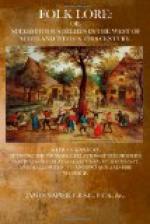The Lily had a sacredness associated with it, probably on account of Christ’s reference to it. It was employed as a charm against evil influence, and as an antidote to love philters; but I am not aware of any of these uses being put in practice during this century.
The four-leaved Clover had extraordinary influence in preserving its possessor from magical and witch influence, and enabled their possessors also to see through any deceit or device which might be tried against them. I have seen a group of young women within these few years searching eagerly for this charmed plant.
The Oak, from time immemorial, has held a high place as a sacred tree. The Druids worshipped the oak, and performed many of their rites under the shadow of its branches. When Augustine preached Christianity to the ancient Britons, he stood under an oak tree. The ancient Hebrews evidently held the oak as a sacred tree. There is a tradition that Abraham received his heavenly visitors under an oak. Rebekah’s nurse was buried under an oak, called afterwards the oak of weeping. Jacob buried the idols of Shechem under an oak. It was under the oak of Ophra, Gideon saw the angel sitting, who gave him instructions as to what he was to do to free Israel. When Joshua and Israel made a covenant to serve God, a great stone was set up in evidence under an oak that was by the sanctuary of the Lord. The prophet sent to prophesy against Jeroboam was found at Bethel sitting under an oak. Saul and his sons were buried under an oak, and, according to Isaiah, idols were made of oak wood. Abimelech was made king by the oak that was in Shechem. From these proofs we need not be surprised that the oak continued to be held in veneration, and was believed to possess virtues overcoming evil. During last century its influence in curing diseases was believed in. The toothache could be cured by boring with a nail the tooth or gum till blood came, and then driving the nail into an oak tree. A child with rupture could be cured by splitting an oak branch, and passing the child through the opening backwards three times; if the splits grew together afterwards, the child would be cured. The same was believed in as to the ash tree. In the Presbytery Records of Lanark, 1664:—“Compeirs Margaret Reid in the same parish, (Carnwath), suspect of witchcraft, and confessed she put a woman newlie delivered, thrice through a green halshe, for helping a grinding of the bellie; and that she carried a sick child thrice about ane aikine post for curing of it.” Such means of curing diseases were practised within this century, and many things connected with the oak were held potent as curatives.




